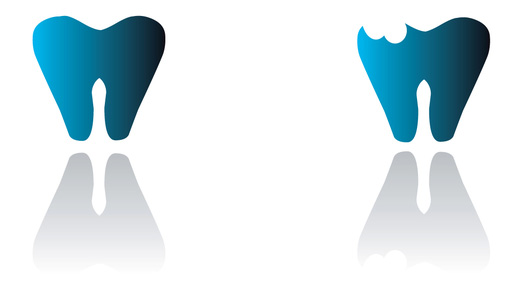Deterioration of the teeth that happens when acid-producing bacteria wear away tooth enamel is a process known as tooth decay. Tooth decay can cause holes in the teeth called cavities. When tooth decay is allowed to go untreated, it can cause toothache, infection and in severe cases, can cause the tooth to die and require extraction. If you are in the San Diego area, and experiencing pain due to decay, visit Brighton Dental San Diego.
To understand what is going on, let’s look at how a tooth is made. The tooth consists of three layers. The outer layer, called the enamel, is the hardest part of the tooth. Under that is the dentin, and the core of the tooth is known as the pulp. The pulp contains nerves and blood vessels that nourish the tooth. The deeper the decay goes, the more serious the damage, and the more invasive treatment becomes.
What causes tooth decay?
Throughout the day a sticky substance consisting of bacteria, called plaque, forms on the teeth. Whenever you eat, these bacteria feed on sugars from the food and produce acid that wears away the enamel for up to twenty minutes after you eat. When these acids are not effectively removed from the teeth, they cause decay. Some habits that contribute to tooth decay are:
- Neglecting healthy oral hygiene, such as thorough daily brushing and flossing,
- Not getting a checkup and cleaning from a dentist,
- Fueling bacteria by consuming excessive sugar and carbohydrates,
- Foregoing fluoride, which is known to strengthen enamel,
- Not producing enough saliva to help remove food particles from the teeth and dilute sugars. Dry mouth can be caused by certain health conditions including diabetes, medications, mouth breathing or simply age, and
- Using tobacco.
Children are more likely to suffer decay because their teeth are still developing and the enamel hasn’t completely hardened, which means their teeth are less resistant to acid erosion. Even babies who have not yet started eating solid food can develop tooth decay. Sugars in baby formula and juice can feed bacteria in an infant’s mouth. When babies fall asleep with bottles the liquid can collect in their mouths.
How do I know if I have tooth decay?
Problem is, you likely won’t know you have decay until a cavity develops. Cavities can cause:
- Tooth pain
- Swollen gums, especially near a painful tooth. Swelling is often a sign of infection
- Bad breath
- Discoloration on the teeth.
If you experience any of these symptoms, see a dentist as soon as you can. Pain may subside, but decay will still get worse, causing the pain to return. Our San Diego dentists can remove the decayed area and fill the tooth to stop the process.
Dealing with TOOTH DECAY
Damage that takes place when acid-producing bacteria in the mouth produce acids that wear away the enamel of the teeth is known as tooth decay. Tooth decay can cause pits in the teeth typically called cavities. When tooth decay is ignored, it can result in toothache, infection or possibly tooth loss.
To find out what is taking place, let’s take a closer look at tooth structure. A tooth is made of three layers. A strong surface layer known as the enamel, a middle layer named dentin and the heart of the tooth, referred to as the pulp. The pulp is made up of nerves and blood vessels. As decay progresses deeper into the tooth, the damage to the tooth becomes more severe.
How does tooth decay happen ?
Plaque, a sticky material that builds up on the teeth, consists of bacteria that feast upon sugars present in your food. As the bacteria digest these sugars, they create acids that harm teeth for twenty minutes or more after your meal. When these acids remain on the teeth, they destroy the enamel and result in decay.
- There are things that you can do to reduce your risk of tooth decay, including:
- Thoroughly brushing twice a day and flossing daily,
- Seeing a dentist twice a year,
- Limiting your intake of sugar and carbohydrates,
- Using fluoride, which has been shown to reinforce the enamel and make it less vulnerable to decay,
- Having enough saliva to get rid of food particles. There are a number of things that can contribute to insufficient saliva production, including diabetes and other health conditions, certain medications, mouth breathing and simply growing older,
- Not using tobacco products
Children tend to be more susceptible to tooth decay due to the fact that their teeth are still maturing and the enamel is softer, causing their teeth to be weaker and more susceptible to deterioration from acids. Infants who have not started solid foods are not immune to tooth decay. Baby formula, milk and juice all contain sugars that feed bacteria that cause decay.
How can I tell if I have tooth decay?
Odds are you won’t unless you get a cavity or abscess. As this happens you will probably suffer:
- Toothache
- Inflamed gums next to an aching tooth. Inflammation can signal extreme decay or an abscessed or diseased tooth,
- Offensive breath or terrible taste in your mouth, or
- Dark spots on the teeth
In the event you suffer a toothache, see a dentist for a visit immediately. The pain may subside, but, the tooth will continue to decay. Delaying treatment, will make the cavity continue to grow, the ache will come back, and the tooth could even die and have to be pulled. A dental professional can eliminate the decayed section and fill the tooth, avoiding additional pain.
Reference: www.sandiegocosmeticdentists.org


